
The 10 Largest Iron Ore Mines in the World
Iron, the chemical element Fe, is one of the world’s most important metals. While it is the most abundant element on earth by mass, this element is used throughout human society. This ranges from advanced uses like the creation of alloy steels like carbon steel and the development of reinforced concrete to day-to-day items like the chain in your bicycle or popes in your home. With so much utility, iron is possibly the most important metal in the world. That said, there’s more to the story. Along with its utility, there are many interesting facts that follow with this heavy metal:
- The human body contains about 4 grams of iron in the form of hemoglobin.
- Iron is one of the most common elements in the universe.
- A lot of Iron is magnetic in nature and is used in all sorts of magnets.
- It is quite heat resistant, with a melting point of 1536°C and a boiling point of 2861°C.
- Steel cannot be produced without iron, making it essential for modern-day construction.
- The first known iron production began in the Middle Bronze Age (3300-1200 BCE), but its true utility wasn’t discovered until much later.
With such importance palpable throughout both human history and growth, it is obvious why this metal is sought after. To this end, the question arises: where does iron come from? The answer to this is quite surprising; unlike many other resources, iron forms when high-mass stars explode. Thus, all the iron on Earth comes from meteorites after stellar explosions. Over the years, this metal merges with other elements in the crust, such as oxygen, gand, and clay, to form iron ore. We mine this ore today to supply our utility of this famed heavy metal.
As more and more iron is needed each year to supply healthcare, construction, automobiles, and other sectors, mining has also increased. As of 2023, humans mined over 2,500 million tones of usable iron ore worldwide, and the number is rising. Some mines across the world stand out, making up a significant portion of this number alone. Here are ten of these top mines and how much iron ore they produced in 2023.
1. Serra Norte Mining Complex (Brazil) - 102,800,000 tonnes (226 billion pounds)
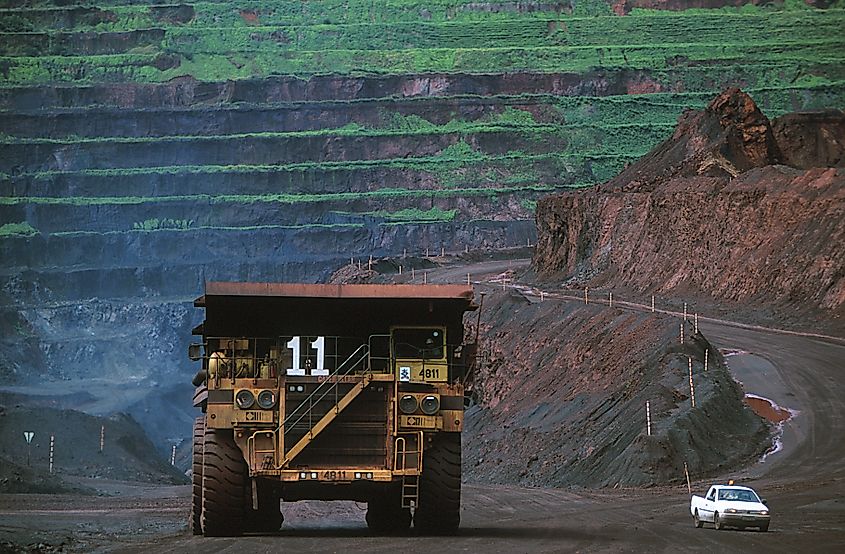
One of the oldest mines on this list, the Serra Norte Mining Complex in Para, Brazil, began operation in 1984. It was developed by Vale S.A., one of the largest mining companies in Brazil. Since then, the complex has expanded to include N3, N4W, N4E, N5 mines, N1 and N2 projects, and three beneficiation plants. It is currently the largest iron ore mine in the world, with a whopping production of 102,800,000 tonnes (226 billion pounds).
Along with the immense current production, the Serra Norte Mining Complex is still growing. There are plans to open multiple new mining areas and convert Plant 1 to a 10% natural moisture process. According to current reserves and these plans, the mining complex should continue production until 2038.
2. Carajas Serra Sul S11D Project (Brazil) - 76,670,000 tonnes (153 billion pounds)
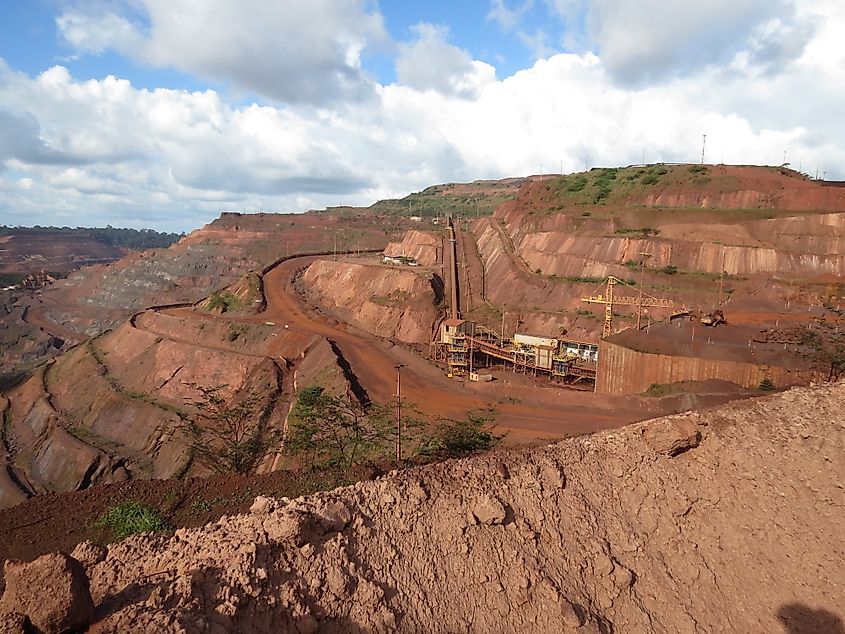
Carajas Serra Sul S11D Project is another iron ore mine in the Para region of Brazil operated by Vale S.A. However, this mine is much newer and began production in 2016 with a whopping investment of $19.5 billion. As of today, it is the second-largest mine in both Brazil and the world, with a production of 76,670,000 tonnes (153 billion pounds).
The large-scale production is thanks to various factors, such as their truckless mining technique, streamlined logistics systems, and rich ore reserves. However, the main benefit that boosts production and growth is the location of this mine. It lies in the mining concession area of the Carajas National Forest, which features over 18 billion tonnes of iron ore reserves. To this end, mining can continue for many decades without any depletion issue. Moreover, Carajas Serra has ample room for growth via infrastructure and can support up to 230 million tonnes per year.
3. Mt Newman Joint Venture (Australia) - 66,990,000 tonnes (134 billion pounds)
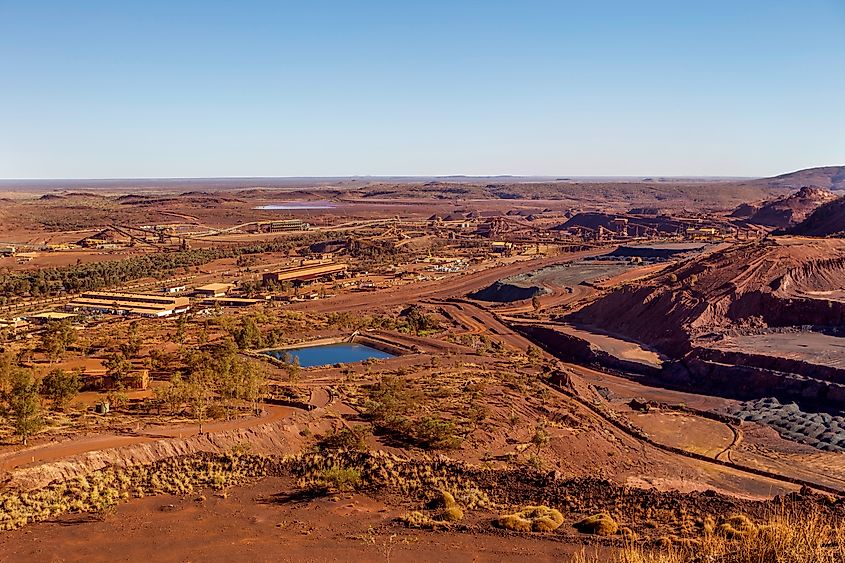
Moving away from Brazil, the third largest iron ore mine in the world is the Mt Newman Joint Venture in Western Australia. It is part of Western Australia Iron Ore (WAIO), which consists of four processing hubs and five mining hubs. This mine itself is owned by multiple companies, with the largest shareholders being BHP Group Ltd and Mitsui-Itochu Iron Pty Ltd. According to recent figures, the Mt. Newman Joint Venture has a production of 66,990,000 tonnes (134 billion pounds) per year. Moreover, as it is located in the iron-rich region of Pilbara in Western Australia, the mine is set to continue production at this pace for at least 25 more years.
4. Jimblebar Hub (Australia) - 66,800,000 tonnes (133 billion pounds)
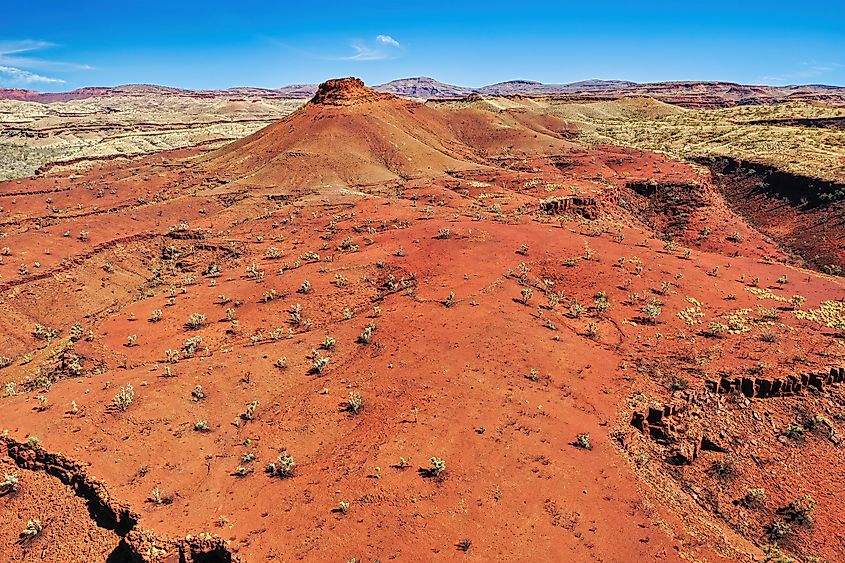
About 40 miles from Newman in Pilbara, Western Australia, Jimblebar Hub is another Western Australia Iron Ore (WAIO) mine. It was opened in 1989 and has since grown immensely due to expansion projects. Since its inception, the mine has been wholly owned by BHP Group Ltd and is now one of their seven mines in the iron-rich Pilbara region. In terms of production, the mine uses a two-stage crushing circuit to produce a whopping 66,800,000 tonnes (133 billion pounds) of iron ore annually, making it the world's fourth-largest iron ore mine.
In addition to its own production, the mine also processes ore from other locations. Specifically, the Wheelara deposit, a joint venture of BHP and various Asian countries, sends iron ore to Jimblebar for processing. The mine is also set for growth, with projects like the BHP Billiton Iron Ore Rapid Growth Project (RGP) aimed to boost site infrastructure.
5. Area C Mine (Australia) - 58,470,000 tonnes (117 billion pounds)
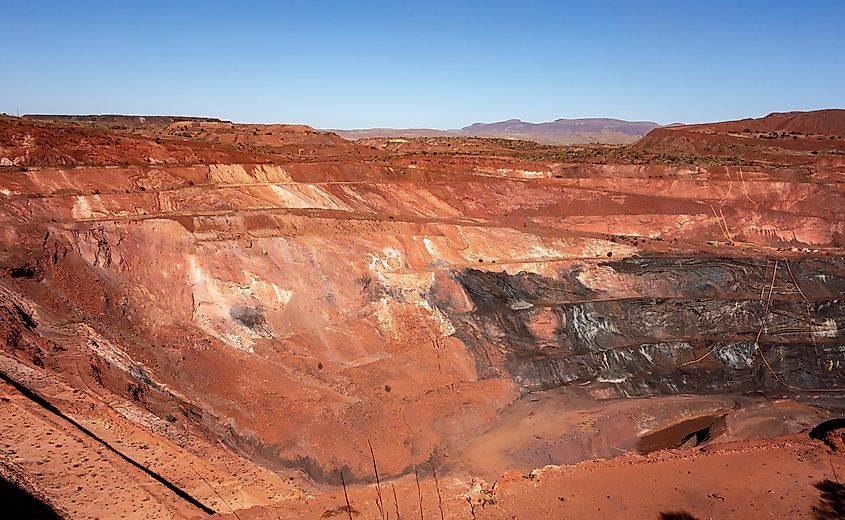
Similar to the previous two, Area C Mine is another massive iron ore mine in the Pilbara region of Western Australia and part of Western Australia Iron Ore (WAIO). This mine was opened in 2003 by BHP in partnership with the South Korean steel maker POSCO and is majority-owned by BHP Group Ltd. Today, the mining facility features eight open-cut mines, three ore handling plants, and one train load-out facility. The complex is also connected to the mines at Newman and Yandi via a 39 km (24 mi) spur line that leads straight to Port Headland for export. Thanks to this robust infrastructure, the Area C Mine produces 58,470,000 tonnes (117 billion pounds) of iron ore per year, making it the fifth largest globally.
6. South Flank Project (Australia) - 56,000,000 tonnes (112 billion pounds)
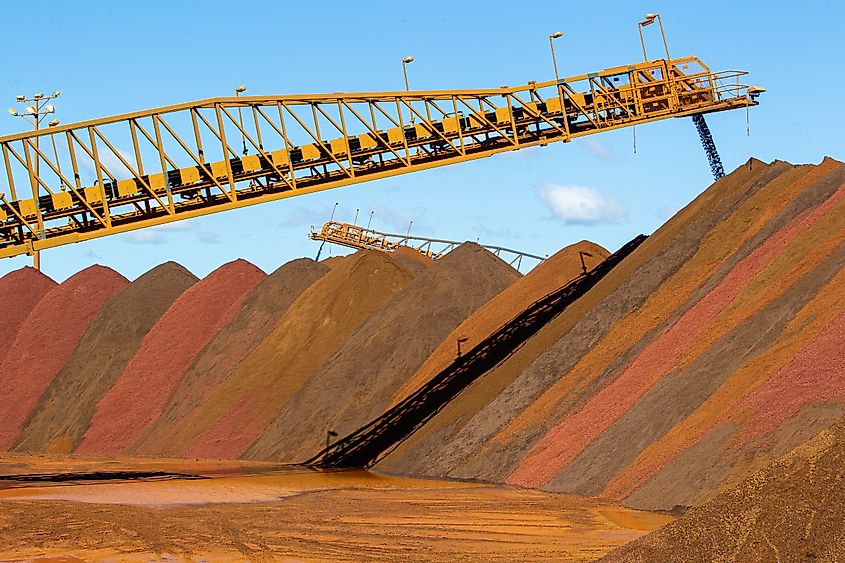
Just nine kilometers south of Area C Mine, the South Flank Project is another of BHP’s iron ore mines in Pilbara. The mine first mined iron ore in 2021 and has since been growing rapidly. According to recent estimates, it currently has an annual production of 56,000,000 tonnes (112 billion pounds), which puts it at sixth in the world. However, unlike other facilities on this list, this mine is only partially complete. Construction is in full swing, and with an investment of US $3.6 billion, it is expected to be the largest iron ore mine in Western Australia once complete.
In addition to its immense production, South Flank is also a wellspring for the local job industry. It currently has over 9,000 direct and indirect employees in operation and construction roles. Moreover, the project has an expansive mining camp with a gym, a virtual golf area, and even a cafe.
7. Greater Tom Price Mine (Australia) - 51,620,000 tonnes (103 billion pounds)
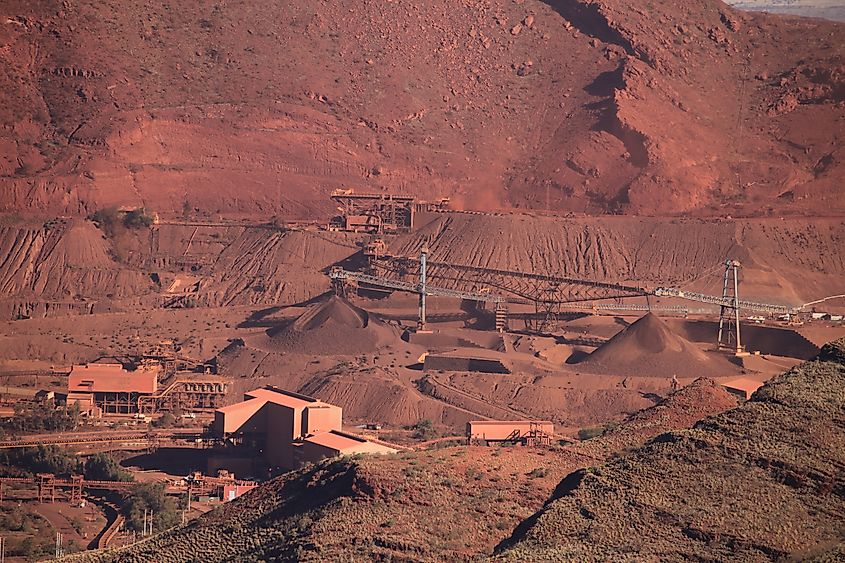
The Greater Tom Price Mine is also located in Pilbara, Western Australia, but unlike the previous four mines, it is not part of the WAIO or owned by BHP. Instead, this project is solely owned by Rio Tinto and has a surface mine layout. Thanks to the abundance of resources in Pilbara and the large-scale facility, the Greater Tom Price Mine has an iron ore production of 51,620,000 tonnes (103 billion pounds), which is seventh in the world.
Along with its infrastructure, the Great Tom Price Mine is supported by the mining town of Tom Price. This town has a population of around 3,000, and most people make a living by working in and around the mine.
8. Kings Valley Mine (Australia) - 51,290,000 tonnes (103 billion pounds)
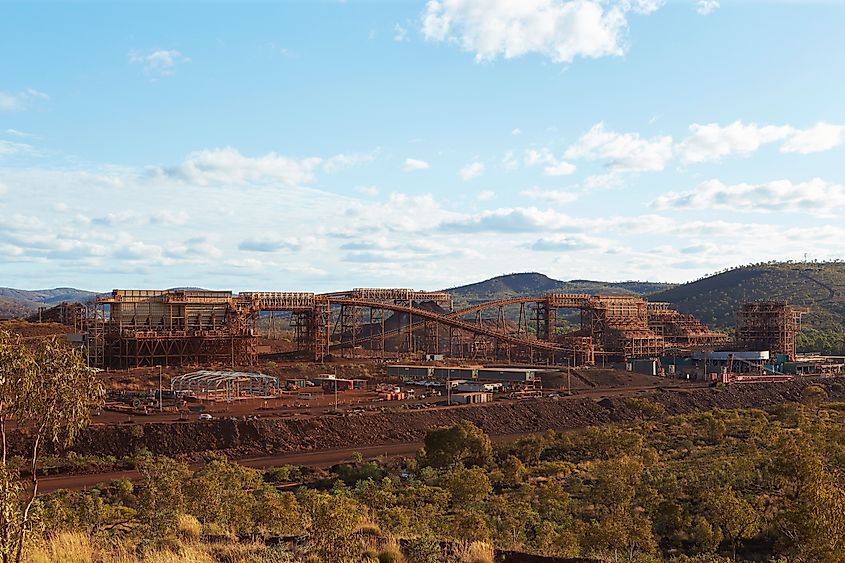
Also in Western Australia’s Pilbara region, the Kings Valley Mine is an iron ore mine owned and operated by Fortescue Metals Group. It is part of the company’s Solomon Hub mining area and was opened in 2014. That said, opening the mine was quite troublesome as it lies on traditional Yindjibarndi people's land, which led to many disputes. However, once the company received approval, it was quickly built and connected to the existing Fortescue railway via a new 127 km (79 mi) line. Based on figures from 2024, the mine produces 51,290,000 tonnes (103 billion pounds) of iron ore annually and is the eighth-largest iron ore mine in the world.
9. Yandicoogina Mine (Australia) - 51,100,000 tonnes (102 billion pounds)
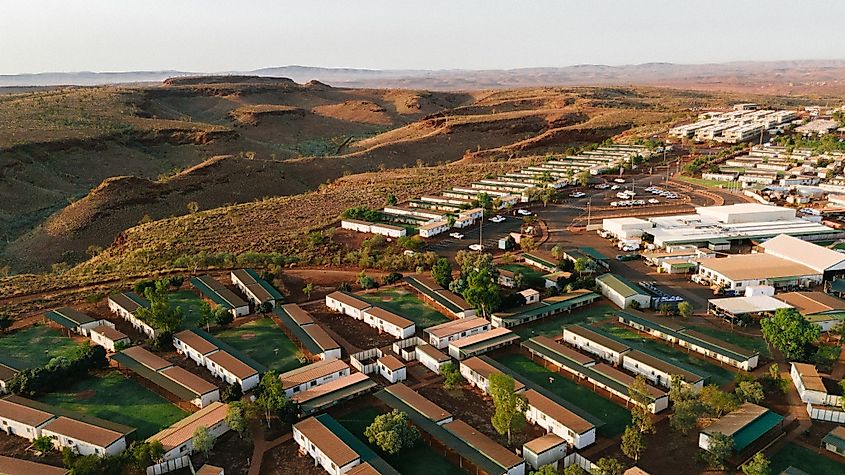
The Yandicoogina Mine is another one of Rio Tinto’s iron ore mines in the Pilbara region of Western Australia. It was opened in 1998 as an open-pit mine and has since been functioning continuously. All iron ore mined by the Yandicoogina Mine is processed on-site and then loaded onto the Hamersley & Robe River railway, which takes it to the coast for shipping. Thanks to this efficient process, this mine is the ninth-largest iron ore mine in the world, with an annual production of 51,100,000 tonnes (102 billion pounds).
In addition to its immense production, the Yandicoogina Mine is also Rio Tinto’s lowest-cost mine. This is due to an array of factors including, but not limited to, its scale, simplicity of the local resource, and low strip ratio. Moreover, further development indicates that the mine will continue production until at least 2039.
10. Christmas Creek Mine (Australia) - 47,010,000 tonnes (94 billion pounds)
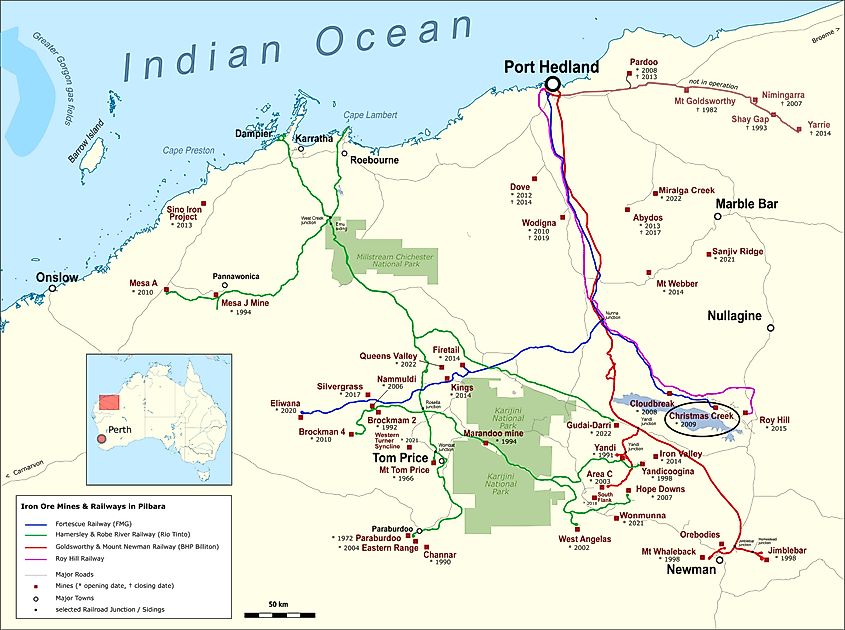
A Fortescue Metals Group endeavor, the Christmas Creek Mine is part of the company’s Solomon Hub mining area in Pilbara, Western Australia. It is one of the newer mines on this list, opened in 2009 with a capital exceeding US $300 million. However, construction was not easy as the mine lies on an Australian Aboriginal sacred site, leading to plenty of land rights disputes over the years. Today, it is the tenth-largest iron ore mine in the world, producing 47,010,000 tonnes (94 billion pounds) of ore per year. The mine itself has an open-pit design and lies on a proven reserve of 315,000,000 tonnes. Adding on 500,000,000 tonnes of estimated reserves, the Christmas Creek Mine should be mining for at least another decade.
Iron Ore Mining & Future Reserves
The Pilbara region in Western Australia stands out as a global hub for iron ore production, hosting multiple of the world's largest mines. As demand for iron continues to surge, mining activities expand, yet the finite nature of iron ore reserves is a growing concern. Technological advancements like AI and robotics are improving efficiency and access to deeper reserves. However, sustainable management is crucial to prevent depletion within the next few decades. Balancing technological innovation with responsible usage will be essential to ensure the long-term availability of this critical resource.











